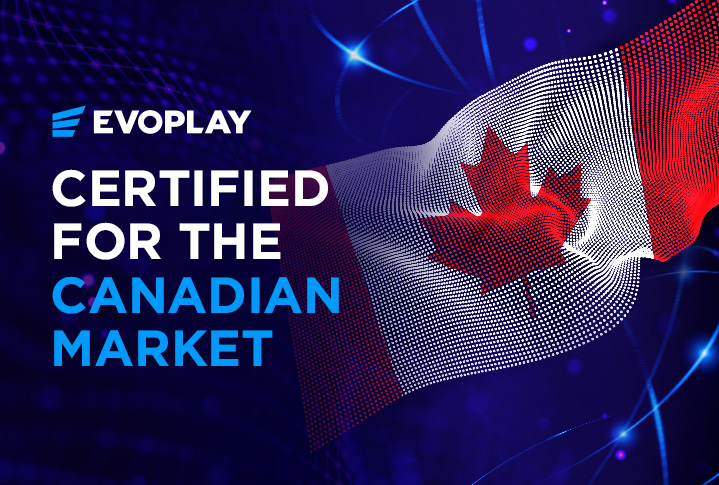
Affiliate marketing is a driving force in iGaming, bringing in highly engaged players and fueling real growth for online casinos. As competition in the iGaming sector intensifies, we’ll explore how affiliate marketing is helping the industry overcome challenges and grow.
For this, we spoke with Diana Larina, Head of Marketing at Evoplay; Alina Famenok, CEO at Already Media; Artem Lashko, COO at Traffic Squad; and Dmytro Miasnikov, COO at AdKey.Agency.
Engaging players: the growing challenge for iGaming
Operating in iGaming is like an endurance race, where the real goal isn’t just reaching the finish line, but establishing lasting connections with players. In marketing terms, this means driving engagement, enhancing retention, increasing lifetime value (LTV), and fostering loyalty to both the brand and its offerings.
“All parties: affiliates, casinos and game providers are interested in cost effective user acquisition campaigns and long-term product retention strategy to ensure players are satisfied with the offerings and business KPIs are met at the same time,” says Diana Larina, Head of Marketing at Evoplay.
She explains that if the provider does not create exciting, retention-focused games, players will leave. If an affiliate brings uninterested players who aren’t ready to engage with the casino, players will leave. And if the casino doesn’t implement the right retention systems, no matter how great the game or traffic is, players will still leave.
“That’s why I believe high retention rates are only achievable with a very deep and well-developed funnel involving all these participants,” adds Diana Larina.
Dmytro Miasnikov, an expert in traffic boosting, emphasises the importance of developing a well-defined player engagement funnel involving all three parties – casino operators, affiliates, and game providers. He suggests that casino operators should focus on the type of audience they are best equipped to serve – whether it’s a warm audience, reached through SEO and PPC, or a cold audience, targeted via channels like Facebook or in-app sources. Once that’s established, the next step is effective retention strategies, bonus systems, and other methods. To providers, he advises exploring ways to collaborate with affiliates, as their offerings are an important part of the acquisition campaigns.
“Don’t lose traffic. As traffic purchasing becomes more technologically advanced, we’re seeing that more traffic can fall off. Check your funnels, create smart links, and direct your traffic back there,” adds Dmytro.
Artem Lashko, who also works with traffic, shares the view on the importance of well-developed funnels for each involved party, with a focus on retention: “Retention is everything. Affiliates need funnels that keep users engaged through push reminders, while operators should go all-in on loyalty – emails, calls, bonuses, you name it. The more touchpoints, the longer players stick around.”
Shifting the focus from constant acquisition to retaining existing players can be a more effective way to manage costs and support more stable revenue over time, considers Alina Famenok, CEO at Already Media. She also adds, “Affiliates reduce risk by spreading their traffic across multiple sources instead of relying entirely on platforms like Google Search.“
As the industry moves towards more strategic collaboration, Alina suggests that providers and operators can play a crucial role by sharing richer player data, running joint campaigns, and treating affiliates as genuine partners, rather than just a source of clicks.
Summing up the discussion on player engagement, Diana Larina points out that 2025 will be a year of closer collaboration between affiliates, providers, and operators.
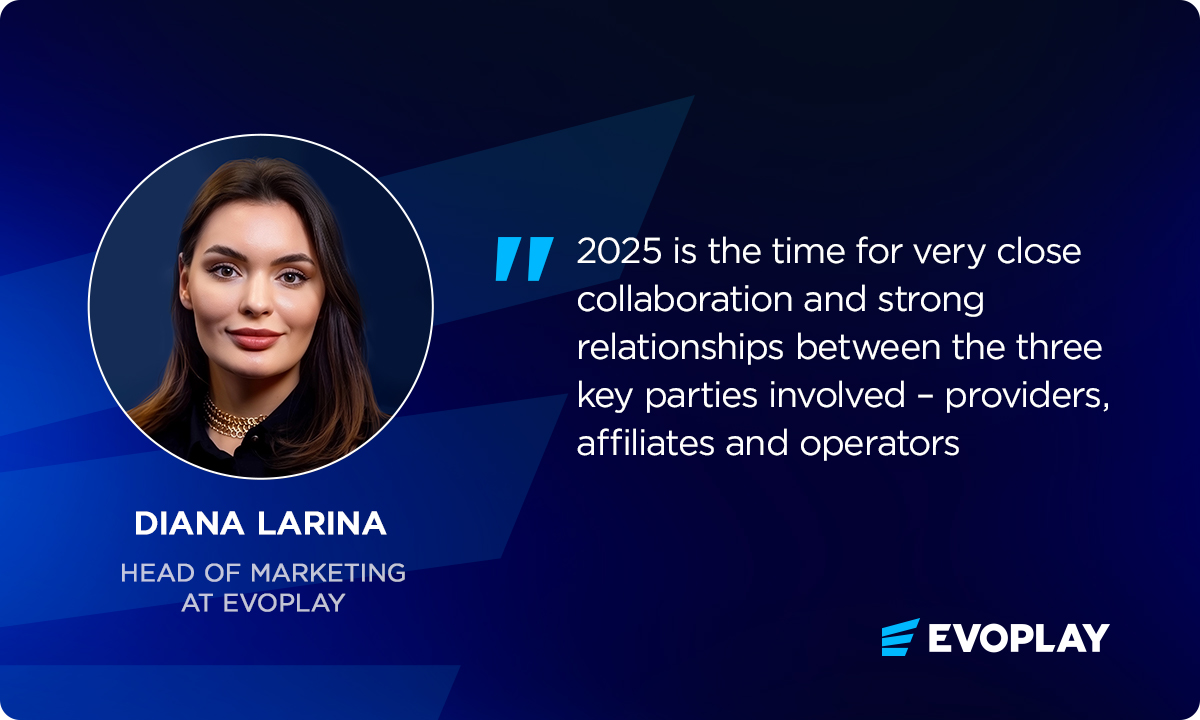
Focus areas in 2025
45.3% of affiliate marketers say getting traffic is their biggest challenge, according to open-source data. But, around this challenge, there are many other issues that need to be solved.
Cost optimisation and efficiency
As the cost of acquiring players rises – along with costs for innovation, team building, and other business needs – affiliates and marketing teams regularly work on optimising their strategies.
Evoplay’s dual focus on SEO and affiliate marketing has been a major part of their strategy. Diana Larina shared, “We’ve been investing in SEO for a long time, with profits now six times higher than our monthly investments. We’ll continue to develop this area further.” She also highlighted that in 2025, the company will focus more on building its brand through affiliate marketing, stressing the importance of choosing the right partners and channels to optimise collaboration and effectively reach the target audience.
Dmytro Miasnikov pointed out the value of finding a balanced CPA (the cost per action) model between affiliates and advertisers. He explained that misaligned rates can lead to unprofitable outcomes, such as when expensive funnels drive traffic that doesn’t meet the target CPA, or when cheaper funnels generate low-value traffic.
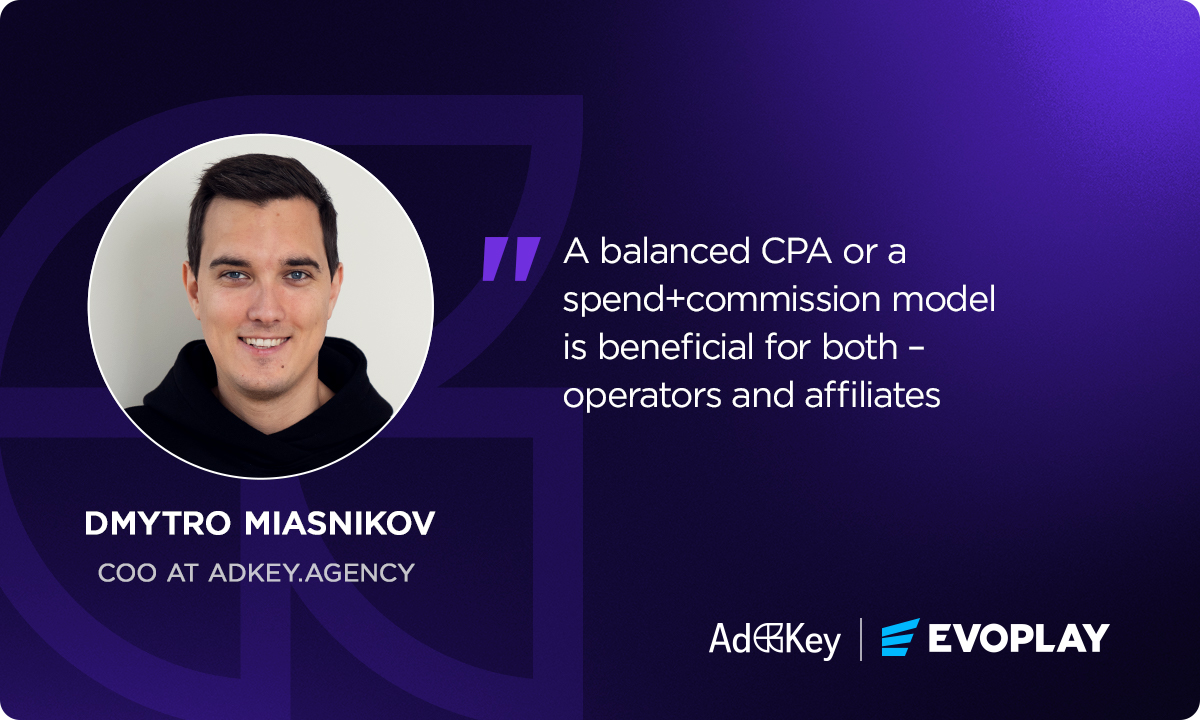
In a similar vein, Artem Lashko underscores the importance of high-quality traffic to reduce risks: “We hate losing money, so we minimise risks by focusing on quality traffic. No clickbait, no shady tactics. Short-term tricks kill retention, so we rely on solid creatives and deep data analysis (ours + partner stats). A long-term win-win strategy beats quick gains every time.”
To reduce costs, Dmytro Miasnikov recommends dividing them into two categories: traffic-related and operating costs. For traffic costs, he advises outsourcing tasks like accounts, applications, creatives, and trackers when the team is small. “For example, in a Facebook marketing team, don’t start developing your own applications until you’re reaching at least $1 million in monthly turnover. Only bring these in-house as the team expands and needs arise,” he says. He also suggests optimising internal processes by clearly assigning roles and responsibilities.
Artem, on the other hand, shares his approach: “There are two ways to cut costs: negotiate better deals or bring things in-house. We push for discounts by leveraging volume or switch to more affordable options. At the same time, we’re building internal teams, like an in-house design department, instead of outsourcing.
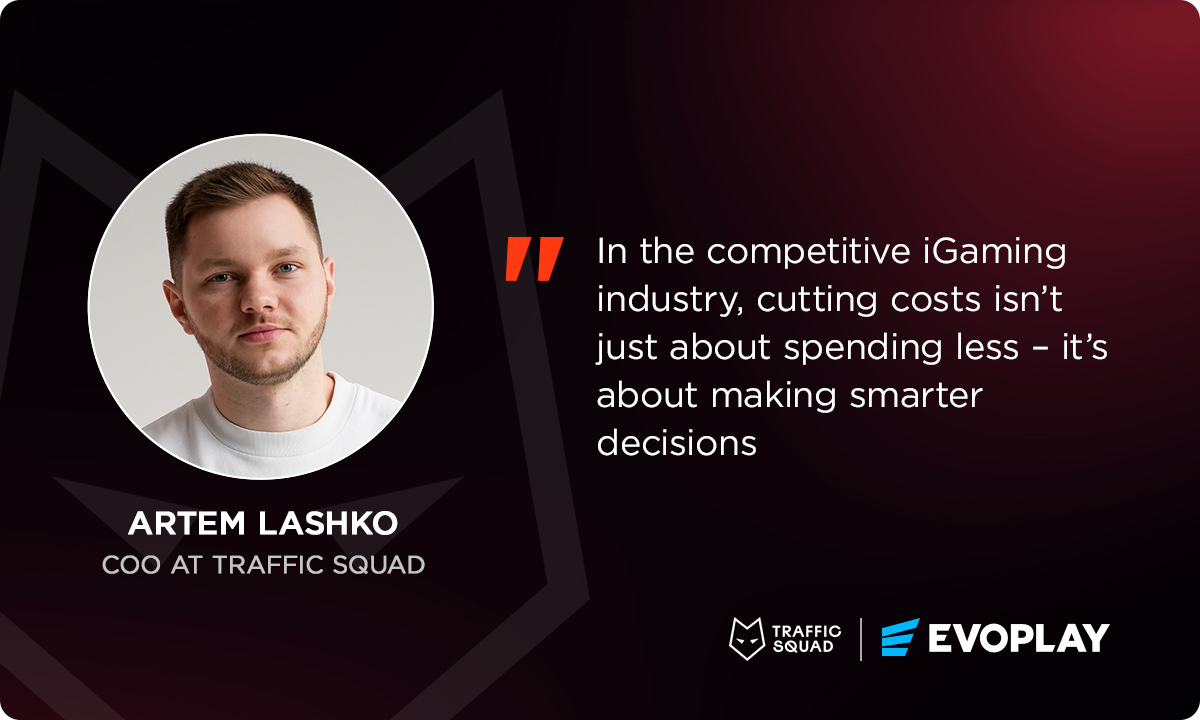
AI’s growing role in analytics and creativity
The experts also agree that analytics, creativity, and the role of AI will increasingly influence workflow optimisation. While AI’s effects can be mixed, it holds significant potential.
Dmytro Miasnikov noted that “AI has given small iGaming entrepreneurs a chance in the battle for traffic – this is a positive impact.” However, he raised concerns about the risks, adding that many specialists – copywriters, translators, designers, and programmers – are starting to lose value as AI handles their tasks efficiently.
“AI is a lifesaver for crafting creatives and speeding up research. It’s not handling everything yet, but give it time,” Artem Lashko added about AI’s potential.
Meanwhile, Diana Larina highlighted the value of AI-powered tools, such as affiliate trackers, for traffic analysis and content generation, including video. Alina Famenok agrees with this perspective, adding that AI also helps better analyse behavioural analytics and tailored content to better match individual player preferences.
Personalisation, gamification and brand building: the path forward
Personalisation and gamification are becoming increasingly important in iGaming. Why? As studies show, content tailored to players’ behaviour and more entertainment options keeps them engaged. For example, HubSpot says 58% of users are more likely to convert when content matches their interests.
This confirms the growing focus on promoting games rather than the creators or the casinos where they’re hosted. In the end, this approach is likely to benefit both.
Diana Larina shares: “It’s time to build a brand around most resonating products. For instance, we do it by boosting our popular games like the football-themed line: Penalty Shoot-Out and its sequels Penalty Shoot-out: Street, and recently released Penalty Shoot-out: Super Cup.”
Her idea is shared by affiliates. For instance, Artem Lashko says: “A known product is easier to push – it simplifies ad creatives and boosts CTR. Players might not care who made a game like Penalty Shoot-Out, but they recognise the name. This approach grows market reach and makes traffic generation smoother.”
Dmytro Miasnikov continues that: “The player doesn’t really care what casino brand in. The most important thing for players is a bright picture with the game mechanics. So typically, we do not advertise the casinos or other partners themselves; instead, we promote the brands of slot and other games.
He continues that the casino brand is almost never featured in FB advertising – 80% of advertising is related to slots and other games. But, at the same time, Dmytro adds that they are testing funnels tailored to specific casino brands. “They are more expensive, but can potentially give higher LTV to players. However, I do not believe that such bundles in procurement will become widespread.”
Meanwhile, Alina Famenok agrees that there is a noticeable shift towards promoting individual products in iGaming but also draws attention to the fact that focusing too heavily on short-term campaigns can hold affiliates back. She explains that while these promotions might deliver a quick traffic spike, long-term success depends on building a brand that players recognise and trust.
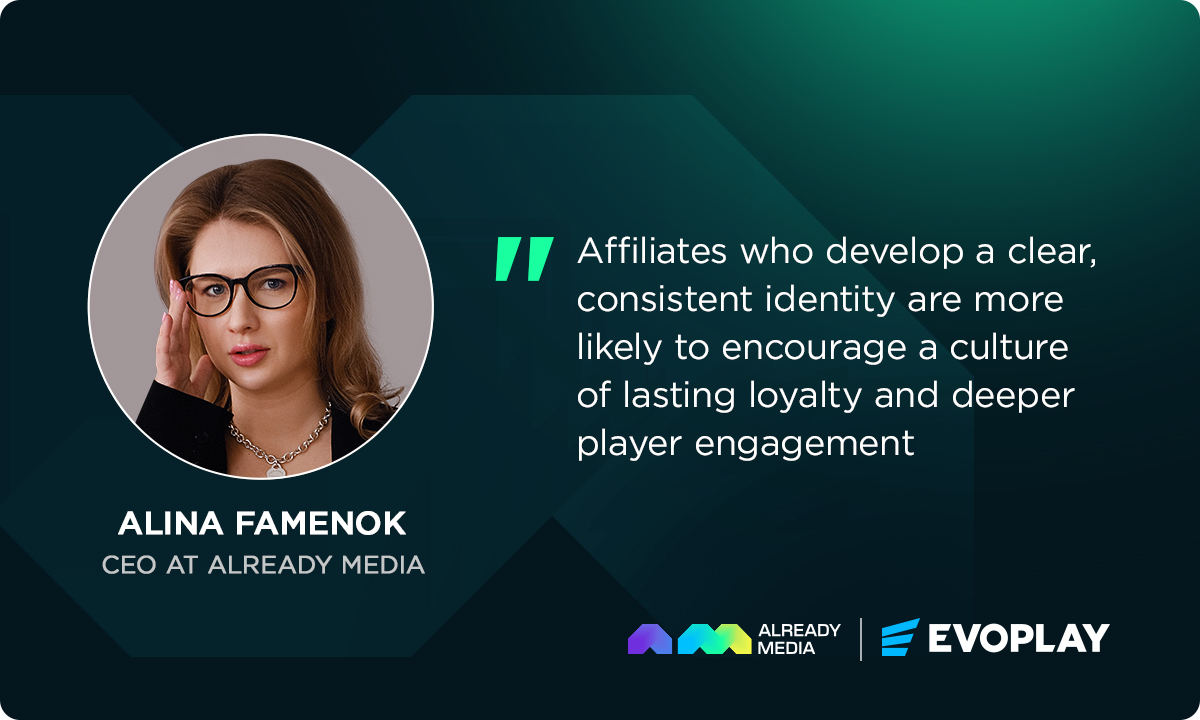
While personalisation mainly helps attract players, gamification keeps them engaged by adding excitement and rewards. Game creators, affiliates, and casinos all use gamification.
Diana Larina, representing Evoplay, emphasises the importance of incorporating gamification both in game design and in their promotion. She explains that Evoplay intentionally integrates gamification elements into their games, particularly those with mechanics that modern players enjoy, such as crash or skill-based features. At the same time, Evoplay uses gamified promotional tools to engage players with rewards and excitement, which contributes to higher retention rates.
From an affiliate perspective, Artem Lashko also sees gamification as a powerful tool. He shares, “It works – if done right. Gamification keeps players hooked with points, missions, and rewards. For us, it’s gold for warming up cold traffic. But if the process is too long or complex, players bounce. Balance is key: engage, but don’t overcomplicate.“
In addition to its positive effects, Alina Famenok warns that if gamification is poorly executed, it can feel forced or superficial, potentially damaging trust or requiring more resources than it returns. Alina also highlights a clear shift away from generic messaging towards more customised experiences that reflect how players interact with platforms. “Looking forward, more advanced technology is expected to drive this even further, with features like real-time game suggestions and AI-powered chat tools helping to boost engagement and satisfaction,” she predicts.
By combining personalisation with gamification, iGaming participants create engaging, tailored experiences that keep players around longer and build loyalty. Together, these strategies make the player journey more exciting and rewarding.
Conclusion
Optimising workflows, cutting costs, and scaling processes help iGaming industry participants work smarter and connect with players better. These strategies will keep changing, but one thing’s clear: collaboration is key to better results. When everyone in the ecosystem – from affiliates to providers and operators – does their part well, everything runs smoother. That way, we immerse iGamers in an exciting journey and build lasting loyalty.
























